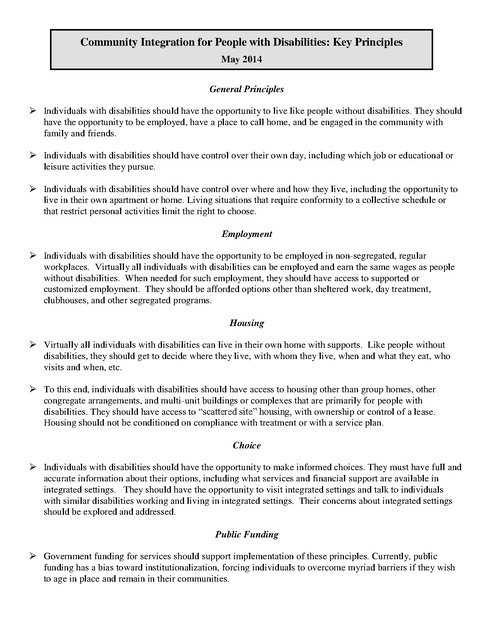Community Integration for People with Disabilities - Key Principles, May 2014
Download original document:

Document text

Document text
This text is machine-read, and may contain errors. Check the original document to verify accuracy.
Community Integration for People with Disabilities: Key Principles May 2014 General Principles Individuals with disabilities should have the opportunity to live like people without disabilities. They should have the opportunity to be employed, have a place to call home, and be engaged in the community with family and friends. Individuals with disabilities should have control over their own day, including which job or educational or leisure activities they pursue. Individuals with disabilities should have control over where and how they live, including the opportunity to live in their own apartment or home. Living situations that require conformity to a collective schedule or that restrict personal activities limit the right to choose. Employment Individuals with disabilities should have the opportunity to be employed in non-segregated, regular workplaces. Virtually all individuals with disabilities can be employed and earn the same wages as people without disabilities. When needed for such employment, they should have access to supported or customized employment. They should be afforded options other than sheltered work, day treatment, clubhouses, and other segregated programs. Housing Virtually all individuals with disabilities can live in their own home with supports. Like people without disabilities, they should get to decide where they live, with whom they live, when and what they eat, who visits and when, etc. To this end, individuals with disabilities should have access to housing other than group homes, other congregate arrangements, and multi-unit buildings or complexes that are primarily for people with disabilities. They should have access to “scattered site” housing, with ownership or control of a lease. Housing should not be conditioned on compliance with treatment or with a service plan. Choice Individuals with disabilities should have the opportunity to make informed choices. They must have full and accurate information about their options, including what services and financial support are available in integrated settings. They should have the opportunity to visit integrated settings and talk to individuals with similar disabilities working and living in integrated settings. Their concerns about integrated settings should be explored and addressed. Public Funding Government funding for services should support implementation of these principles. Currently, public funding has a bias toward institutionalization, forcing individuals to overcome myriad barriers if they wish to age in place and remain in their communities. These community integration principles are embraced by: ADAPT American Association of People with Disabilities American Diabetes Association Association of University Centers on Disabilities The Arc of the United States Autistic Self-Advocacy Network Bazelon Center for Mental Health Law Depression and Bipolar Support Alliance Disability Rights Education and Defense Fund Easter Seals International Association of Peer Supporters Little People of America Mental Health America National Alliance on Mental Illness National Association of Councils on Developmental Disabilities National Association of Rights Protection and Advocacy National Association of State Directors of Developmental Disabilities Services National Association of State Mental Health Program Directors National Coalition for Mental Health Recovery National Council for Community Behavioral Healthcare National Council on Independent Living National Disability Rights Network National Federation of the Blind National Mental Health Consumers’ Self-Help Clearinghouse National Organization on Disability Paralyzed Veterans of America TASH United Spinal Association

